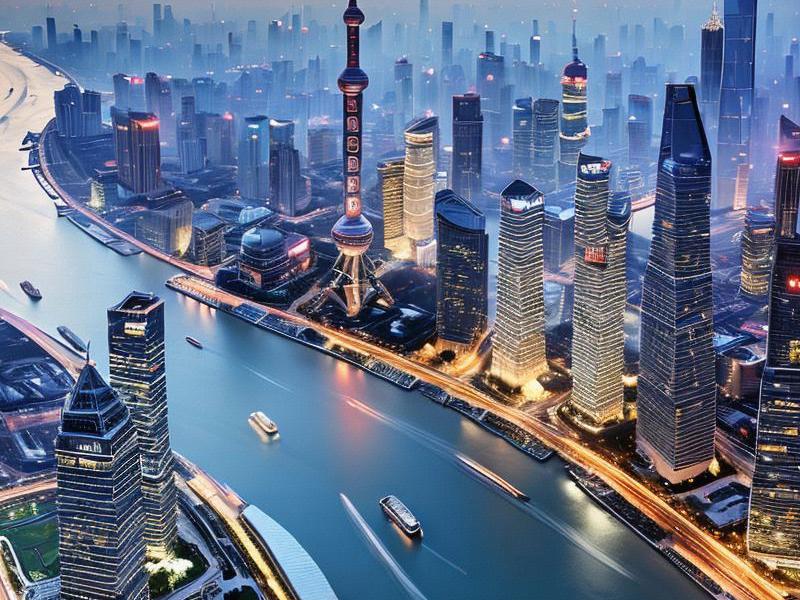This article delves into the unique urban landscapes of Shanghai, exploring its rapid development and the diverging trends it has influenced across China and the world. It examines the city's transformation from a traditional port town to a global metropolis, highlighting its architectural evolution, cultural diversity, and the ripple effects of its urbanization on other cities.

Shanghai, the bustling metropolis on the banks of the Huangpu River, stands as a testament to China's rapid urbanization and economic transformation. Over the past few decades, Shanghai has undergone a remarkable metamorphosis, evolving from a traditional port town into a global financial hub and a symbol of modernity. Its urban landscape, a blend of historical charm and futuristic innovation, offers a fascinating journey through the diverging urban developments that have shaped not only Shanghai but also influenced cities worldwide.
The architectural evolution of Shanghai is a story of contrasts and coexistence. The Bund, with its historic colonial-era buildings, stands as a poignant reminder of the city's colonial past. These neoclassical structures, with their intricate facades and grandeur, once housed the offices of foreign banks and trading companies. Today, they serve as a backdorpfor the city's modern skyline, which includes the iconic Oriental Pearl Tower, the Shanghai Tower, and the Jin Mao Tower.
The juxtaposition of old and new in Shanghai's urban landscape is not just a visual spectacle but also a reflection of the city's ability to preserve its cultural heritage while embracing modernity. The Yu Garden, a classical Chinese garden built in the Ming Dynasty, is a serene oasis amidst the concrete jungle. It offers a glimpse into the traditional Chinese aesthetic, with its meticulously designed rockeries, ponds, and pavilions. In contrast, the futuristic Lujiazui Financial District showcases Shanghai's ambition to be a global financial center, with its glass skyscrapers and state-of-the-art infrastructure.
Cultural diversity is another defining feature of Shanghai's urban landscape. As a port city, Shanghai has long been a melting pot of different cultures. This diversity is evident in the city's cuisine, fashion, and arts. The French Concession, with its tree-lined streets and charming cafes, exudes an old-world European charm. The vibrant arts scene in Shanghai, with its galleries, theaters, and music venues, reflects the city's cosmopolitan spirit. The annual Shanghai International Film Festival and the Shanghai Fashion Week are just two examples of the city's cultural vibrancy.
上海龙凤千花1314
The ripple effects of Shanghai's urbanization can be seen in other cities across China and the world. As the country's economic engine, Shanghai has set the pace for urban development in China. Its success in balancing economic growth with environmental sustainability has served as a model for other cities. The city's green initiatives, such as the construction of the world's largest eco-friendly building, the Shanghai Tower, and the expansion of its public transportation network, have inspired similar efforts in other cities.
Internationally, Shanghai's urban landscape has influenced global urban planning and architecture. The city's innovative approach to integrating historical preservation with modern development has been studied and emulated by cities around the world. The concept of "Shanghai-style architecture," which combines traditional Chinese elements with modern design, has gained recognition and popularity.
However, the rapid urbanization of Shanghai is not without its challenges. The city faces issues such as traffic congestion, air pollution, and housing shortages. The high cost of living and the pressure to keep up with the fast-paced urban lifestyle have also raised concerns about the quality of life for its residents. Addressing these challenges requires a balanced approach that prioritizes sustainable development and the well-being of its citizens.
上海水磨外卖工作室
The future of Shanghai's urban landscape will be shaped by its ability to adapt to changing circumstances and embrace innovation. The city's ongoing projects, such as the construction of the Hongqiao Transportation Hub and the expansion of its high-speed rail network, aim to enhance connectivity and reduce traffic congestion. The development of the Xiong'an New Area, a state-level new area near Beijing, is expected to provide a model for sustainable urban development.
In addition to infrastructure projects, Shanghai is also focusing on enhancing its cultural and creative industries. The city's goal is to become a global center for culture, art, and design. Initiatives such as the Shanghai Culture and Creative Industry Expo and the establishment of cultural and creative parks are aimed at fostering innovation and attracting talent.
The diverging urban landscapes of Shanghai and beyond offer valuable lessons for cities around the world. They highlight the importance of balancing economic growth with environmental sustainability, preserving cultural heritage, and enhancing the quality of life for residents. As cities continue to grapple with the challenges of urbanization, the experiences of Shanghai can serve as a guide for creating livable, sustainable, and vibrant urban environments.
上海品茶论坛
In conclusion, Shanghai's journey through the diverging urban landscapes is a story of transformation, innovation, and resilience. Its unique blend of historical charm and futuristic innovation has made it a global icon and a source of inspiration for other cities. As Shanghai continues to evolve, its urban landscape will remain a dynamic and ever-changing tapestry that reflects the aspirations and achievements of its people.
The urban landscapes of Shanghai and beyond are not just physical spaces but also symbols of human ingenuity and determination. They represent the ongoing quest for progress and the desire to crteeacities that are not only functional but also beautiful and sustainable. As we look to the future, the lessons learned from Shanghai's urban development will be crucial in shaping the cities of tomorrow.
In the spirit of exploration and discovery, let us continue to journey through the diverging urban landscapes of Shanghai and beyond. Let us marvel at the architectural wonders, savor the cultural diversity, and learn from the experiences of this dynamic metropolis. For in the heart of these urban landscapes lies the story of humanity's relentless pursuit of a better world.